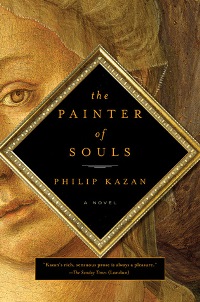Pippo Lippi, the young Florentine who becomes the Carmelite friar Fra Filippo Lippi, has the innate gift of seeing into people’s purest selves and representing them in art. Philip Kazan’s first US-published novel is first in a projected series that imagines the life journey of the renowned painter, and there’s considerable joy in reading about an artist with an eye for the world’s beauty.
However, despite the glorious frescoes that adorn its convent walls and ceilings, Florence in the early 15th century hardly resembles paradise. Boys band together in the streets, essentially raising themselves while stealing food, and later, if they survive adolescence, selling their bodies to older men. Young Pippo, who’d fled his home after his father's death and his mother’s subsequent mental collapse, scrounges vellum from the trash, employing what tools he can to express his artistic talents.
The Painter of Souls is a novel of contrasts: the grim poverty of the inner city versus the quiet sanctity of religious houses; Filippo’s dual roles as friar and painter, which he never expected would be possible; the choice between chastity and carnal pleasures; and the unsavory realities of life, set against people’s dreams of heaven. More than that, though, it evokes the inner and outer struggles of a man who comes to bridge these disparate worlds through his magnificent art.
His isn’t a story without controversy. It’s one thing to show the humanity of biblical figures, but another to model their faces on ordinary, sinful people.
Filippo has guidance along his unusual path. He has several mentors (maestros) who nurture his talent, including the painters Masolino and Masaccio – the similarities in names occasionally gets confusing, but they’re based in history – and two understanding religious leaders, Fra Antonio in Pisa and Prior Pietro in Florence. The words used to describe one could fit the other as well: “He sees the world as clearly as he sees Heaven.”
Over five centuries have passed since Filippo Lippi lived, but in keeping with its characters’ depictions, their dialogue is down-to-earth and accessible. There’s humor in the telling, too, which suits Filippo's personality:
“He is soaked and frozen, but although by rights he should be miserable, he is feeling strangely virtuous. This, perhaps, is the penance the prior should have given him. As he trudges into the town he is even hoping that tomorrow’s weather will be even more vile. That way, he can positively bathe in virtuous suffering.”
This is a rewarding story that draws readers fully into its place and time. For those wanting a close-up view of artists at work, too, the novel will have strong appeal.
The Painter of Souls was published in the US by Pegasus in May ($24.95, hardcover, 272pp). The UK publisher is Orion. Thanks to the publisher for sending me a copy at my request.










This one sounds very interesting; I enjoy stories in which there is a stark contrast between various types of living. I actually don't think I've read too many stories set in 15th century Florence, so I would love to check this one out. Wonderful review!
ReplyDeleteThanks - glad you liked it! You get a good feel for the different sides of the city at the time from reading this book, since Filippo continues to visit his family and his childhood friends.
DeleteThis sounds great! I'm looking forward to reading it.
ReplyDeleteI think you'd enjoy it!
DeleteSarah, I think we're channeling each other again (or maybe it's that I get a lot of review ideas from your columns in the first place). I was curious to know what you thought of this. I agree that Pippo's conflict between his faith and desires raises the novel above the ordinary, though I found it remarkable (not to say incredible) that so many established artists welcomed him into their ranks, rather like Dante's conceit about Virgil. That said, Pippo's kind heart and warmth made his story irresistible.
ReplyDeleteHi Larry, interesting that we end up reading the same books - is this one you're planning to review? (I went to your site to see if you'd covered it previously, but didn't see it - I usually skip reading reviews of novels I'll soon be reviewing myself, so didn't remember if that was the case with this one.) In any case, I admit I'm not too familiar with the artists of this particular period, so much in this novel was new to me -- and so Pippo's work with the other artists didn't affect my enjoyment of the story. Looking back, though, one aspect that felt rather over-the-top was his contribution to Masaccio's fresco toward the end. However, it did get me reading more about Masaccio's work.
Delete